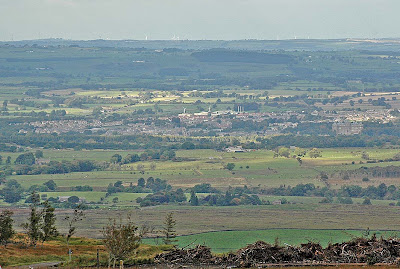
Much that is reported in the media about wildlife is bad news - usually about catastrophic declines in species abundance, so the rapid northwards extension of the range of the speckled wood butterfly has been somewhat under-appreciated. This butterfly was known in Victorian times as the Wood Argus or Wood Lady and in the 1870 edition of his History of British Butterflies the Rev. F.O. Morris described it a being "...a common species in all parts of the country, from the extreme north to the extreme south..." but it seems that by then it was already declining in the north. By 1986 T.C. Dunn and J.D. Parrack, in their Moths and Butterflies of Northumberland and Durham lamented that "We must now consider it to be extinct in out two counties, but it still survives in Yorkshire and it is theoretically possible for it to return". I don't think I'd seen one of these delightful insects in County Durham until about five years ago, although I'd occasionally seen them in North Yorkshire, but now they are just about everywhere I look. They arrived in woodlands around Durham city about three years ago and are now so frequently seen that the novelty has already worn off. They have even turned up in my garden on several occasions this year, where I hope that their larvae might make inroads into the common couch that is one of their food plants, along with cock's foot grass and Yorkshire fog.

The speckled wood's ability to produce two generations a year and overwinter as a larva or a pupa must have some bearing on the speed that it establishes itself once it arrives. This is a species where the males are highly territorial and in the ten minutes that I spent watching the individual in these photographs it twice fought short but furious aerial dogfights with an intruder, spirally upwards before returning each time to this sunlit leaf once it had seen it off; a remarkable display of aggression in such an apparently fragile insect. The butterfly literally defends its own personal patch of sunlight, where it poses to attract the attention of a female. Dr Paul Whalley, an entomologist at the Natural History Museum described this territoriality in detail in his book Butterfly Watching in 1980 and suggested that the males probably scent mark their territory. Describing six contesting the same patch of sunlight, he wrote "They flew in an up and down, follow-my-leader fashion which resembled a well-drilled dance routine". Male and female speckled woods are hard to tell apart but the artist and naturalist David Measures came up with a sure-fire solution to the problem in his book Bright Wings of Summer. "Unless you have a male and female side by side it is difficult to distinguish the sexes by the markings" he wrote, but noted that it's 'undoubtedly a cock if it flies up at everything that passes, in true territory-claiming style..." Measures' book, published in 1976, is full of delightfully spontaneous watercolours of butterflies, produced during a decade of patient and meticulous field studies of butterfly behaviour, that perfectly evoke the vibrancy of these wonderful insects - it's well worth reading if you can find a copy.








































































